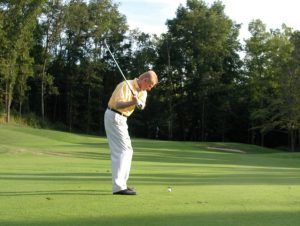P6 – The Gateway to Your Best Ball Striking

by Dr. T.J. Tomasi A Legacy Post by Keiser University College of Golf Senior Faculty and Director of Research (1940-2023)
When the center of mass of the clubface is inside the hand path, the clubface will automatically attempt to line up with the hand path during release – this is just the way rotational mechanics of the swing works. Thus, to be in a perfect, natural release position, the face plane must begin to drop inside the hand plane as you exit the transition at the top of the swing. All great players accomplish this move, but in some swings – like Sergio Garcia- the shallowing of the clubhead is obvious.

The shaft is too vertical – it should be under my shoulder at this point in the downswing.

While it doesn’t look like much, there is a meaningful difference between the angles created between the hand plane and the clubface plane. Note how the shaft is below the back shoulder for this professional and the clubface shallows as it drops under the hand plane.
I have written several articles on the release, and in my terminology, I call this key part of the swing the number six position P6. So important is P6 to good ball sticking that if my student has already learned the fundamentals of grip, stance, posture, etc., I often fast forward the tape to P6 to see if it is correct.
In my teaching I emphasize the fact that the golf swing is ‘something to nothing,’ meaning that by the time you get to the P6, where your lead arm is parallel with the ground, it’s too late to make adjustments, because you don’t have enough time before impact (See research in the Search for the Perfect Swing). Fortunately, if your P6 is correct, the club releases on its own with a natural power separate from, but added to, the muscle power and timing that creates clubhead speed.
Because a correct P6 contains this additional source of power, it is the ‘Holy Grail’ that all golfers should be searching for. Please note that its most famous cousin, Impact (P8), is much overrated for three reasons:
- Because the downswing happens so fast, impact is a result, not a cause
- Impact is out of the player’s control, and, therefore, any conscious attempt to manipulate impact is fatal
- Unless P6 is correct, P8 lacks the natural power source conferred by physics, leaving the player to rely on strength and timing, two fickle components that, by themselves, foster manipulation.
And there is another huge advantage to being in a correct P6 – not only do you access a natural source of power, but also the clubface naturally squares to the hand path, providing an accurate strike. In other words, once you create a correct P6, you have to work hard to screw it up at impact. Conversely, if you are in an incorrect P6, emergency compensations and manipulations are called for, most of which fail under pressure.
Thus, the difference between a good player and a sub-elite is that a sub-elite often operates out of an inferior P6, and until they fix it, they will continue to struggle no matter how hard they practice.
Golf Putting Takeaway
It is axiomatic that your golf swing will never be any better than your concept of what a good golf swing is, so, rather than focusing on impact, the goal of the entire swing should be to arrive at P6 correctly because it is your gateway to both power and accuracy.

Now you can see how much the clubface center of mass has shallowed vs. the hand plane. Note how the shaft lays across the forearm.
If you’d like to study with Dr. Tomasi and other PGA Master Professionals, contact The College of Golf today.















I thought lead arm parallel to ground was P5. P6 is shaft parallel to ground.
P-5 or P6 the shaft is still inside the hand path
While I agree that P6 is the most important checkpoint, your post is referring to P5 which I don’t agree is as critical. More things can still go wrong with a correct P5 than can with a correct P6.